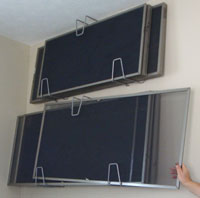Spring Maintenance Project Checklist
Organizing projects as spring makes its way, will aid in getting your house
in shape while preventatively livening-up the inside and outside for the new season.
Interior Maintenance Areas:
 Windows/Doors
Windows/Doors - Clean the windows with glass cleaner, both sides
and look at the windows, particularly if the end of the warranty period is approaching. Searching for
failure at the glass seals, frames and all parts. Replace screens in their frames that have been cleaned. Inspect door and window seals
for air-tightness, to reveal drafts.
Furnace/AC/HVAC - clean or replace filters as needed including for humidifier.
Reset thermostat range if needed. Some systems require regular checkups by qualified personnel.
Laundry Room Duct - check for lint buildup and clean inside duct as needed. Flexible coil type ducts
tend to collect debris more often than metal and should require more care when cleaning.
Garage - see that automatic openers move as they are intended and that sensor lenses are clean and aligned with connections intact.
You might run a wall duster before cleaning the floor that will also keep the house clean.
Walls - dust the walls with an extendable duster. Replace home security alarm batteries if it is within a reasonable time.
Note any patching/paint work.
Flooring - clean and inspect all flooring. View all areas of ingress and egress. Clean and seal tile/grout if needed. Which will help
keep it that way. And check that carpet transition areas are firmly down near bordering floor types.
Basements - look for signs of water leaking and if you find anything, contact a pro. Inspect the sump pump and back-up if there is one, to discharge
the water to come.
Exterior Maintenance Areas:
Roof - View the roof areas for shingles that are out of place. These are
possible spots of water infiltration. That are not complicated repairs to make, better than having to fix
rain water damage on the ceilings inside the home.
Gutters/Drainage - there should yet be a slope around the house to drain away water.
The downpouts, and grated drain areas should be checked for debris. Look at gutters and make repairs for sagging
that might have been caused by snow loads.
Siding/Painting - view the siding and evaluate if there is any painting, cleaning or treatment necessary.
Noting that no wood should show exposed. Pressure washing is a quick way to clean down the sides.
Also try to spot any rusty metal at the earliest stages while it is easier to refinish.
Caulking - inspect around windows, doors and all areas that may have missing or caulking failure. Which
should be replaced with a quality compound applied.
Masonry/Chimneys - look for cracking and separation at the masonry joints. If there are any,
re-pointing may be an option. It is important that water should not be entering through any cracks or failures
in the joints or bricks themselves.
Foundation/Concrete - inspect the foundation and make note of any cracking. This should be addressed
by a pro and it might require an evaluation. Walk the concrete drive and walkways - are there signs of cracking or separation?
Decks - blow or sweep fallen debris. Floor slat gaps should be clean thus promoting circulation.
View for damage to the deck, stairs, and rails and if there is additional cleaning needed.
Awnings - the fabric awnings usually should be laundered professionally. If they had been removed,
this might be the time.
Outside AC/Compressor Unit - clear off any debris. There should be free air-flow above and around the outer shroud.
Doors/Windows - replace storm door glass panels with screens, place glass panels in storage.
Due to the change in weight, adjust the closure mechanisms for a more gentle shutting.
Landscaping - consider putting ground cover down on new bedding, before spreading mulch.
Limbs, branches and vegetation should be trimmed away from the house. Look to the trees for pieces of stuck branches.

 Windows/Doors - Clean the windows with glass cleaner, both sides
and look at the windows, particularly if the end of the warranty period is approaching. Searching for
failure at the glass seals, frames and all parts. Replace screens in their frames that have been cleaned. Inspect door and window seals
for air-tightness, to reveal drafts.
Windows/Doors - Clean the windows with glass cleaner, both sides
and look at the windows, particularly if the end of the warranty period is approaching. Searching for
failure at the glass seals, frames and all parts. Replace screens in their frames that have been cleaned. Inspect door and window seals
for air-tightness, to reveal drafts.